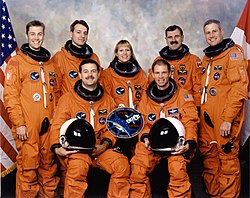STS-90
| Mission emblem | |||
|---|---|---|---|

|
|||
| Mission dates | |||
| Mission: | STS-90 | ||
| COSPAR-ID : | 1998-022A | ||
| Crew: | 7th | ||
| Begin: | April 17, 1998, 18:19:00 UTC | ||
| Starting place: | Kennedy Space Center , LC-39B | ||
| Landing: | May 3, 1998, 16:08:59 UTC | ||
| Landing place: | Kennedy Space Center, Lane 33 | ||
| Flight duration: | 15d 21h 50min 58s | ||
| Earth orbits: | 256 | ||
| Rotation time : | 89.9 min | ||
| Orbit inclination : | 39.0 ° | ||
| Apogee : | 286 km | ||
| Perigee : | 257 km | ||
| Covered track: | 10.4 million km | ||
| Payload: | Spacelab | ||
| Team photo | |||
 v. l. No. Front: Scott Altman, Richard Searfoss; Back: James Pawelczyk, Richard Linnehan, Kathryn Hire, Davydd Williams, Jay Buckey |
|||
| ◄ Before / After ► | |||
|
|||
STS-90 ( english S pace T ransportation S ystem) is the mission designation for a flight of the US Space Shuttle Columbia ( OV -102) of NASA . The launch took place on April 17, 1998. It was the 90th space shuttle mission and the 25th flight of the Columbia space shuttle.
team
Main team
- Richard Searfoss (3rd space flight), commander
- Scott Altman (1st spaceflight), pilot
- Richard Linnehan (2nd spaceflight), mission specialist
-
Dafydd Williams (1st Spaceflight), Mission Specialist ( CSA / Canada )


- Kathryn Hire (1st spaceflight), mission specialist
- Jay Buckey (1st spaceflight), payload specialist
- James Pawelczyk (1st spaceflight), payload specialist
replacement
-
Alexander Dunlap and Chiaki Mukai ( NASDA / Japan ) for Buckey and Pawelczyk

Mission description
The Columbia mission was Spacelab's 22nd and final deployment . During the NeuroLab mission, the main focus was on the functioning of the brain . For this purpose, studies were carried out on humans and animals . In addition to the 7 space travelers, there were also 18 pregnant mice , 152 rats , 135 snails , 229 swordtail fish , 4 oyster fish and 1514 crickets on board . Most of the animals, however, were either killed and examined in orbit or after landing. A large number also died in flight. Investigations concerned embryonic development , brain tissue and activity as well as the sense of balance . For this purpose, the oyster fish had special electrodes implanted in the inner ear .
Extensive investigations were also carried out on four astronauts. Sleep was carefully examined in all its phases (brain and body functions). The coordination of brain and body movements was also researched. To do this, the test subjects had to catch balls and follow points of light with their eyes. Other tests covered adaptation to weightlessness, the function of the sense of balance, the use of medication for space traveler's disease , the treatment of insomnia, dizziness, low blood pressure and symptoms of immunodeficiency .
See also
Web links
- NASA Mission overview (English)
- Video summary with comments of the crew (English)
- NASA video of Mission (English)
